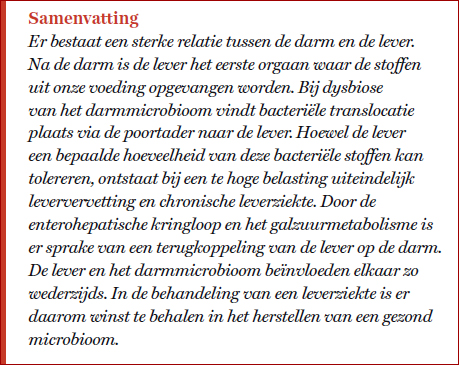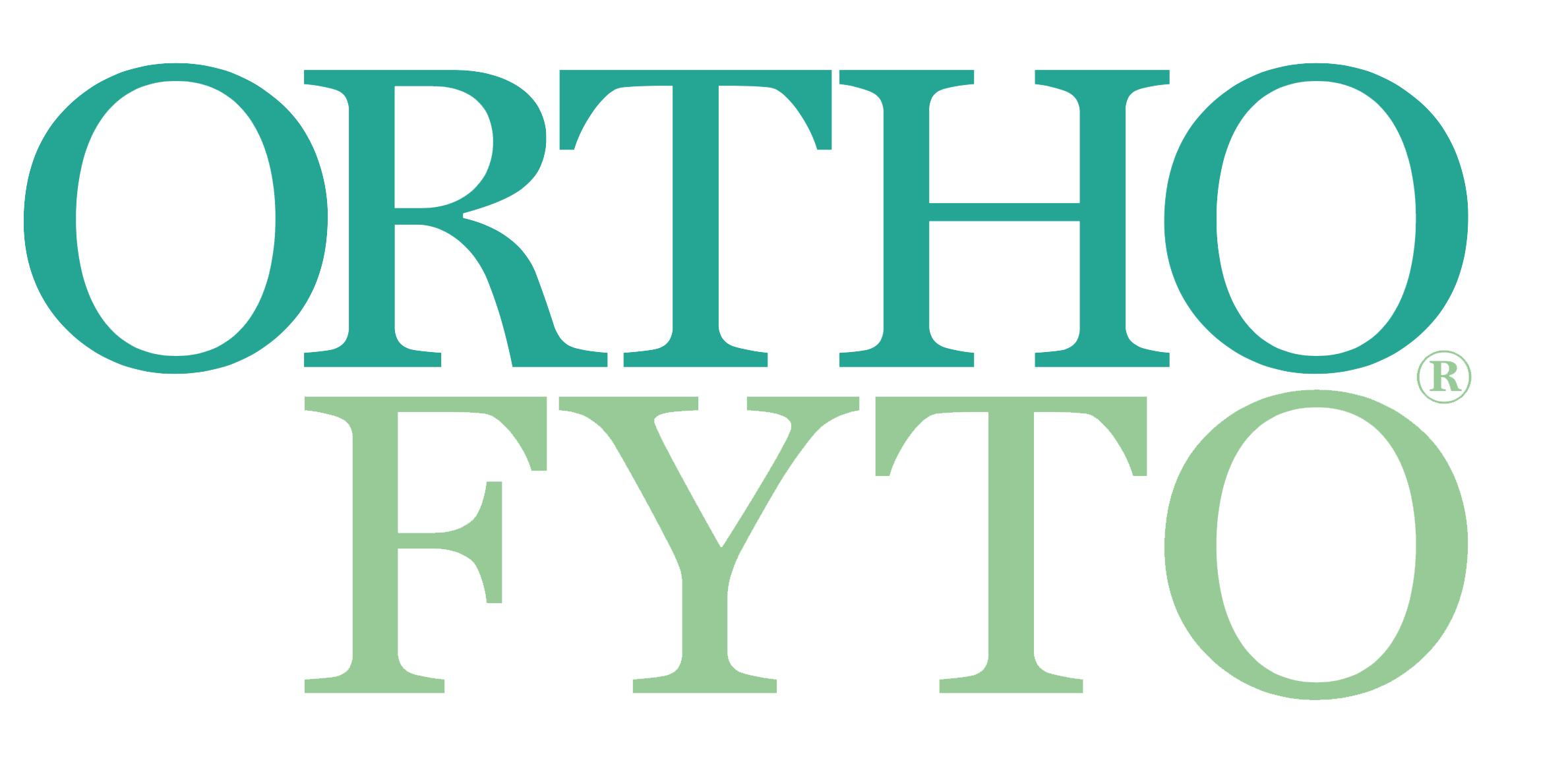De Darm-leveras
08 Oct, 2018
Door: Vera van Randwijck
 Er bestaat een sterke onderlinge relatie tussen de darm en de lever. Fysiologisch komt deze relatie naar voren in de enterohepatische kringloop. Op het gebied van pathologie bestaat de samenhang ook: zo belast een verhoogde darmdoorlaatbaarheid de lever. En een stuwing in de poortader door bijvoorbeeld niet-alcoholische leververvetting vermindert de conditie van de darm. Bij leverfibrose is de galproductie verstoord, wat vervolgens tot dysbiose leidt. In de functionele geneeskunde is oog voor deze samenhang van belang in de diagnostiek, alsook in de behandelkeuze bij darm- en leverziekten.1
Er bestaat een sterke onderlinge relatie tussen de darm en de lever. Fysiologisch komt deze relatie naar voren in de enterohepatische kringloop. Op het gebied van pathologie bestaat de samenhang ook: zo belast een verhoogde darmdoorlaatbaarheid de lever. En een stuwing in de poortader door bijvoorbeeld niet-alcoholische leververvetting vermindert de conditie van de darm. Bij leverfibrose is de galproductie verstoord, wat vervolgens tot dysbiose leidt. In de functionele geneeskunde is oog voor deze samenhang van belang in de diagnostiek, alsook in de behandelkeuze bij darm- en leverziekten.1
Na de darm is de lever het eerste orgaan waar de stoffen uit onze voeding opgevangen worden. Via de poortader komt voedselrijk bloed, met de stoffen die we in de darmen opnemen, eerst de lever binnen. Deze moet ervoor zorgen dat mogelijke niet-gunstige stoffen (soms zelfs gifstoffen) omgezet worden en niet de rest van het lichaam bereiken. Tussen die stoffen zitten ook altijd bacteriën die toevallig meegekomen zijn. De lever vangt deze op met de zogenaamde Kupffer-cellen, macrofagen die de bacteriën ongedaan kunnen maken. Het bloed uit zowel dunne als dikke darm verzamelt zich in de poortader om naar de lever vervoerd te worden. Dus zowel bacteriën of stoffen van bacteriën uit de dunne en dikke darm komen terecht in de poortader.
Hoe diverser het microbioom, hoe gezonder het is voor ons1, 2; wij zijn gebaat bij een grote diversiteit aan bacteriën. Door verschillende omstandigheden (voedselinfectie/vergiftiging, voedingswijze, antibioticakuur, voedselallergie, voedselintolerantie, stress, etc.) kan het microbioom aan diversiteit verliezen waardoor enkele soorten de overhand krijgen. De pathogene bacterie die gaat overheersen, kan andere, van oorsprong niet-pathogene bacteriën meenemen in een neerwaartse spiraal van pathogene invloed op de darmen (quorum sensing, een soort ‘recht van de sterkste’).
Gebeurt dit in meerdere of mindere mate, dan komt er een reactie vanuit de darmen zelf om het evenwicht te herstellen. De darm reageert onder andere met ontstekingsreacties en maakt meer antibacteriële stoffen aan zoals secretoir-IgA (sIgA) en beta-defensine. Darmepitheel kan onder invloed van de pathogene bacteriën gaan irriteren, waardoor de verbindingsstukken tussen cellen geheel of gedeeltelijk kapotgaan (leaky gut). Het gevolg is dat ongewenst materiaal via de poortader in de lever terechtkomt.
Lees het gehele artikel vanaf pagina 24 in OrthoFyto 5/18. Wilt u het hele artikel als PDF ontvangen? Bestel het dan hier voor € 3,50 Bronvermelding:- Woodhouse, C. A., Patel, V. C., Singanayagam, A., & Shawcross, D. L. (2018). Review article: the gut microbiome as a therapeutic target in the pathogenesis and treatment of chronic liver disease. Alimentary Pharmacology and Therapeutics, 47(2), 192–202. Als download beschikbaar.
- D’Argenio, Valeria, and Francesco Salvatore. The Role of the Gut Microbiome in the Healthy Adult Status. Clinica Chimica Acta 451 (December 2015): 97–102.
- Sanduzzi Zamparelli, Marco, Alba Rocco, Debora Compare, and Gerardo Nardone. The Gut Microbiota: A New Potential Driving Force in Liver Cirrhosis and Hepatocellular Carcinoma. United European Gastroenterology Journal 5, no. 7 (November 8, 2017): 944–53.
- Bajaj, Jasmohan S, I Jane Cox, Naga S Betrapally, Douglas M Heuman, Mitchell L Schubert, Maiyuran Ratneswaran, Phillip B Hylemon, et al. Systems Biology Analysis of Omeprazole Therapy in Cirrhosis Demonstrates Significant Shifts in Gut Microbiota Composition and Function. American Journal of Physiology. Gastrointestinal and Liver Physiology 307, no. 10 (November 15, 2014): G951-7.
- Xie, Guoxiang, Xiaoning Wang, Ping Liu, Runmin Wei, Wenlian Chen, Cynthia Rajani, Brenda Y. Hernandez, et al. Distinctly Altered Gut Microbiota in the Progression of Liver Disease. Oncotarget 7, no. 15 (April 12, 2016).
- Wahlströ, Annika, Sama I Sayin, Hanns-Ulrich Marschall, and Fredrik Bä Ckhed. Cell Metabolism Review Intestinal Crosstalk between Bile Acids and Microbiota and Its Impact on Host Metabolism. Cell Metabolism 24 (2016): 41–50.
- Ridlon, JM, DJ Kang, PB Hylemon, and JS Bajaj. Bile Acids and the Gut Microbiome. Curr. Opin. Gastroenterol. 30, no. 3 (2014): 332–38.
- Li, T., & Chiang, J. Y. L. (2014). Bile Acid Signaling in Metabolic Disease and Drug Therapy. Pharmacological Reviews, 66(4), 948–983.
- Lachar, Jatinder, and Jasmohan Bajaj. Changes in the Microbiome in Cirrhosis and Relationship to Complications: Hepatic Encephalopathy, Spontaneous Bacterial Peritonitis, and Sepsis. Seminars in Liver Disease 36, no. 04 (December 20, 2016): 327–30.
- Degirolamo, Chiara, Stefania Rainaldi, Fabiola Bovenga, Stefania Murzilli, and Antonio Moschetta. Microbiota Modification with Probiotics Induces Hepatic Bile Acid Synthesis via Downregulation of the Fxr-Fgf15 Axis in Mice. Cell Reports 7, no. 1 (April 2014): 12–18.
